|
|
|
Sort Order |
|
|
|
Items / Page
|
|
|
|
|
|
|
| Srl | Item |
| 1 |
ID:
183181
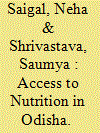

|
|
|
|
|
| Summary/Abstract |
Celebrated as a nutrition champion, Odisha state in India has achieved significant improvements in nutrition of its women and children. The overall progress, however, masks familiar inequities, evidenced in significantly higher levels of stunting, wasting and underweight in children. The article examines access, a key underlying determinant of undernutrition, to two nutrition government schemes of Odisha—the Supplementary Nutrition Programme and Mamata—for the most vulnerable groups in the state’s Angul district. The study identifies limited awareness and lack of proactive disclosure of scheme information, excessive distance from centres that provide the schemes, caste-based power dynamics and weak monitoring institutions as key factors restricting access of specific social groups to these two schemes. The article examines the factors constraining access and considers potential solutions to overcome these bottlenecks in order to provide more effective protection mechanisms.
|
|
|
|
|
|
|
|
|
|
|
|
|
|
|
|
| 2 |
ID:
145579


|
|
|
|
|
| Summary/Abstract |
The general goal of the present study is to analyze whether children with siblings lag behind their only-child counterparts in terms of health and nutrition, cognition and educational performance, and non-cognitive outcomes. We draw on a dataset containing 25 871 observations constructed from three school-level surveys spanning four provinces in China. The analysis compares children with siblings and only children aged 9 to 14 years old in terms of eight different health, cognitive and non-cognitive indicators. We find that with the exception of the anemia rate, health outcomes of children with siblings are statistically indistinguishable from those of only children. In terms of cognition, children with siblings performed better than only children. Moreover, outcomes of children with siblings are statistically indistinguishable from those of only children in terms of the non-cognitive outcomes provided by measures of anxiety. According to our results, the same general findings are true regardless of whether the difference between children with and without siblings is disaggregated by gender.
|
|
|
|
|
|
|
|
|
|
|
|
|
|
|
|
| 3 |
ID:
178160


|
|
|
|
|
| Summary/Abstract |
By 1928, Robert McCarrison’s laboratories in the South Indian hill station of Coonoor had become recognised as the centre for nutritional research in India. Five years earlier, however, his institute had faced closure. This article argues that the establishment of McCarrison’s institute was based on his pitch to the Royal Commission on Agriculture in India in 1926, in which he successfully aligned his research to satisfy the concerns of various members of the Commission. This discussion uses McCarrison’s lobbying for his institute as a case study to examine the broader political manoeuvrings that colonial scientists in the early twentieth century often had to undertake to establish their research agendas.
|
|
|
|
|
|
|
|
|
|
|
|
|
|
|
|
| 4 |
ID:
099166


|
|
|
|
|
| Publication |
2010.
|
| Summary/Abstract |
Migrant workers have become a major element of the labor force in Chinese cities, making important contributions to the economy while forming a socially disadvantaged group. Existing research on the relationship between the level of nutrition and health and income in China mainly focuses on farmers living in rural areas. Based on a Mincer equation and using a survey in Beijing, this paper examines the relationship between migrant workers' nutrition and health levels and their monthly incomes. We find that the nutrition intake and the body mass index have positive effects on income while duration of illness and daily working hours have negative effects. These conclusions imply that the Chinese Government should put more emphasis on improving migrant workers' well-being, including offering educational programs on nutrition and health, and enhancing medical insurance and the old-age insurance system.
|
|
|
|
|
|
|
|
|
|
|
|
|
|
|
|
| 5 |
ID:
119213
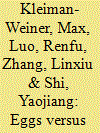

|
|
|
|
|
| Publication |
2013.
|
| Summary/Abstract |
Despite growing wealth and a strengthening commitment from the government to provide quality education, a significant share of students across rural China still have inadequate access to micronutrient-rich regular diets. Such poor diets can lead to nutritional problems, such as iron-deficiency anemia, that can adversely affect attention and learning in school. Large scale policies in Northwestern China have attempted to tackle these nutritional problems using eggs. The overall goal of this paper is to assess the impact of the government's egg distribution program by comparing the effect on anemia rates of an intervention that gives students an egg per day versus an intervention that gives students a chewable vitamin per day. We will also assess whether either intervention leads to improved educational performance among students in poor areas of rural China. To meet this goal, we report on the results of a randomized controlled trial (RCT) involving over 2600 fourth grade students from 70 randomly-chosen elementary schools in 5 of the poorest counties in Gansu Province in China's poor Northwest region. The design called for random assignment of schools to one of two intervention groups, or a control group with no intervention. One intervention provided a daily chewable vitamin, including 5 mg of iron. The other mimicked the government policy by providing a daily egg. According to the findings of the paper, in the schools that received the chewable vitamins, hemoglobin (Hb) levels rose by more than 2 g/L (over 0.2 standard deviations). The standardized math test scores of students in these schools also improved significantly. In schools that received eggs, there was no significant effect on Hb levels or math test scores. Overall, these results should encourage China's Ministry of Education (MOE) to look beyond eggs when tackling nutritional problems related to anemia in an education setting.
|
|
|
|
|
|
|
|
|
|
|
|
|
|
|
|
| 6 |
ID:
165077
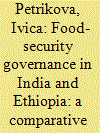

|
|
|
|
|
| Summary/Abstract |
Despite recently legislating the right of all citizens to food security, India continues to suffer high food-insecurity rates. With respect to several measures, food insecurity in India appears to be actually higher than in Ethiopia, a country with only one-fourth of India’s average per-capita income. This article examines comparatively the two countries’ food-security challenges and governance mechanisms and identifies several relevant policy areas for mutual learning – dietary diversity, maternal and infant nutrition, and sanitation as well as food production and programmes’ external oversight. Beyond India and Ethiopia, these findings are pertinent also to other developing countries facing similar food-security challenges, such as Pakistan, Nigeria or Sudan.
|
|
|
|
|
|
|
|
|
|
|
|
|
|
|
|
| 7 |
ID:
180032
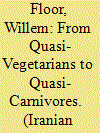

|
|
|
|
|
| Summary/Abstract |
Until the twentieth century there was little change in the diet of Iranians. Bread was the major staple, accompanied by vegetables, fruits, yoghurt, and nuts. Meat and rice were a luxury food for most consumers. In the nineteenth and twentieth centuries new food items were adopted by Persian consumers. After 1970, the modern Iranian diet—large amounts of white rice, meats, sugar-sweetened beverages and sweet/deserts, with few vegetables, herbs, nuts or fruits—has grown increasingly similar to the US diet, with the same health problems.
|
|
|
|
|
|
|
|
|
|
|
|
|
|
|
|
| 8 |
ID:
141108
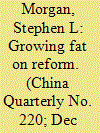

|
|
|
|
|
| Summary/Abstract |
Economic growth over the past three decades has greatly improved the nutrition and living standards of people in China. However, increasingly, the Chinese are becoming heavier. As many as a quarter of Chinese school-age urban boys are overweight or obese, yet a third of Chinese children remain underweight. Drawing on six national surveys of children's health conducted since 1979, the article reports on trends in nutritional status and regional disparities. It shows that the drivers behind the increase in mean body mass and in nutritional inequality are associated with rising household incomes and associated inequalities between provinces.
|
|
|
|
|
|
|
|
|
|
|
|
|
|
|
|
| 9 |
ID:
082556
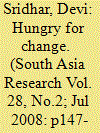

|
|
|
|
|
| Publication |
2008.
|
| Summary/Abstract |
The World Bank has become the largest financial contributor to health-related and nutrition projects, committing more than $1 billion annually towards the health, nutrition and population sector. This article examines how the World Bank addressed malnutrition in Tamil Nadu and discusses the consequences of this approach for the Bank's projects and target communities. Using the case study of the Tamil Nadu Integrated Nutrition Project (TINP), it is argued that the World Bank nutrition package, now implemented in several countries, might not be effective in extremely poor and destitute communities because it does not address the underlying social causes of malnutrition. The final section of the article goes 'inside' the Bank to examine two institutional drivers that could explain the promotion of the TINP approach to undernutrition
|
|
|
|
|
|
|
|
|
|
|
|
|
|
|
|
| 10 |
ID:
138046
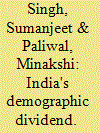

|
|
|
| 11 |
ID:
192372
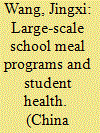

|
|
|
|
|
| Summary/Abstract |
Reducing urban-rural gaps in child health is one of the most difficult challenges faced by many countries. This paper evaluates the impact of a large-scale school meal program in rural China on the health and nutritional status of students aged 6–16 in compulsory education. We use data from the China Health and Nutrition Survey corresponding to four pre-treatment years (2004, 2006, 2009, and 2011) and one post-treatment year (2015) and find that program participation is, on average, associated with a higher child height-for-age. The impacts are larger among students in a better health condition but small or not significant among the most disadvantaged. We do not observe heterogeneous effects across several individual and household characteristics. We also find positive but not significant effects on Body Mass Index-for-age and weight-for-age. The results suggest that NIP partially improved students' health over the first years of implementation, but more support is needed to achieve broader impacts that effectively reach all vulnerable students.
|
|
|
|
|
|
|
|
|
|
|
|
|
|
|
|
| 12 |
ID:
144812
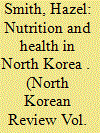

|
|
|
| 13 |
ID:
170174
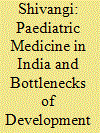

|
|
|
|
|
| Summary/Abstract |
This article argues that the poor state of paediatric medicine in India still restrains and often prevents the healthy development of far too many young Indians. Infants as junior-most citizens deserve diligent care, as they have legal entitlements to specialised medical services, ensuring their survival and healthy growth, ultimately for the benefit of the entire nation. The article first traces the somewhat stunted colonial institutional development of paediatric medicine in India. It then proceeds to perform a critical analysis of the continuing harm of negligence concerning the health and upbringing of India’s vulnerable infants, challenging the state to become more committed to integrated child development.
|
|
|
|
|
|
|
|
|
|
|
|
|
|
|
|
| 14 |
ID:
181528
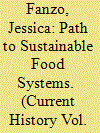

|
|
|
|
|
| Summary/Abstract |
Agriculture systems, which account for a sizable share of global greenhouse gas emissions, are placing a growing burden on the environment while also contributing to increasingly common health problems. Climate change is making the situation worse by reducing agricultural productivity as well as the nutritional content of certain crops, which in turn is driving intensified production to meet global food demand. To break out of this potentially catastrophic feedback loop, societies must realign agricultural policies, financial incentives, and diets to promote health and environmental sustainability.
|
|
|
|
|
|
|
|
|
|
|
|
|
|
|
|
| 15 |
ID:
165918
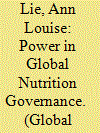

|
|
|
|
|
| Summary/Abstract |
Global public-private partnerships for health and nutrition have proliferated since the 1990s—a trend raising important questions about authority and legitimacy in global governance. Yet within the fields of international relations and public health, there has been only limited empirical research into the global politics and power dynamics behind such partnerships. This article explores how and why the Scaling Up Nutrition partnership was established. Drawing on interviews, observations, and document analysis, it demonstrates how public and private actors exercise combinations of instrumental, structural, and discursive power to normalize and institutionalize their interests and values at the global level. The study highlights as such the complexities behind the increased privatization of global nutrition governance and the importance of power analysis to uncover the normative contestations and asymmetries of power behind global partnership creation.
|
|
|
|
|
|
|
|
|
|
|
|
|
|
|
|
| 16 |
ID:
178163
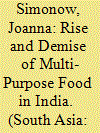

|
|
|
|
|
| Summary/Abstract |
This article traces the transnational history of Indian Multi-Purpose Food (Indian MPF, or simply MPF) to make two contributions to the historiography of development in post-War South Asia. Firstly, it illuminates the involvement of supporters of Indian nationalism in North America, who backed the use of food supplements in India, in the process of mobilising US resources to promote Indian national development in general, and family planning in particular. Secondly, the article sheds new light on the production of development knowledge on food and nutrition in early post-colonial India and the role that food science and technology assumed in national food planning in the first decades after Independence.
|
|
|
|
|
|
|
|
|
|
|
|
|
|
|
|
| 17 |
ID:
078230
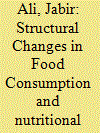

|
|
|
|
|
| Publication |
2007.
|
| Summary/Abstract |
Livestock as an important sub-sector of the Indian agricultural economy plays a multi-faceted role in providing liveli-hood support and food security especially to the country's rural population. There is a growing market for livestock products in India and it is well-documented that consumption patterns have been undergoing significant changes towards high value commodities like fruits and vegetables, milk, meat and eggs. Between 1983 and 1999, consumption of fruits increased by 553 per cent, of vegetables by 167 per cent, and of milk and milk products by 105 per cent. Consumption of meat, eggs and fish rose by 85 per cent over the same period, and these trends have continued since. The article analyses some significant recent structural changes in consumption of livestock products in India and examines their future scope in providing nutritional security. It is argued that despite significant reservations about meat consumption, livestock products have great potential to contribute significantly to the rural Indian economy and in providing better nutritional security for a still growing population
|
|
|
|
|
|
|
|
|
|
|
|
|
|
|
|
| 18 |
ID:
145582


|
|
|
|
|
| Summary/Abstract |
The debate over whether boarding school is beneficial for students still exists in both developing and developed countries. In rural China, as a result of a national school merger program that began in 2001, the number of boarding students has increased dramatically. Little research has been done, however, to measure how boarding status may be correlated with nutrition, health and educational outcomes. In this paper, we compare the outcomes of boarding to those of non-boarding students using a large, aggregate dataset that includes 59 rural counties across five provinces in China. We find that for all outcomes boarding students perform worse than non-boarding students. Despite these differences, the absolute levels of all outcomes are low for both boarding and non-boarding students, indicating a need for new policies that will target all rural students regardless of their boarding status.
|
|
|
|
|
|
|
|
|
|
|
|
|
|
|
|
| 19 |
ID:
095459
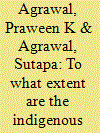

|
|
|
|
|
| Publication |
2010.
|
| Summary/Abstract |
Indigenous populations are the most marginalized and vulnerable communities in India, constituting 8.2% of India's total population, four times larger than the total population of Australia. The state of Jharkhand accounts for 27.7% of the total indigenous population of India. This paper compares the health and socio-economic and demographic indicators among indigenous and non-indigenous women in Jharkhand in terms of 'disadvantage ratio', by exploring the data of 1614 ever-married women (women who are currently married or who have been married at some point in their lives) from India's second National Family Health Survey (NFHS-2), conducted during 1998-99. The study revealed that the indigenous women of Jharkhand were highly disadvantaged in terms of socio-demographic, family planning, and important aspects of maternal health and nutrition compared to non-indigenous women. They were not only disadvantaged within the state in different parameters, but also across the indigenous female population of India as a whole. The findings call for urgent implementation of special health care strategies for reducing health and socio-economic/demographic disparities among the indigenous population of Jharkhand.
|
|
|
|
|
|
|
|
|
|
|
|
|
|
|
|
|
|
|
|
|